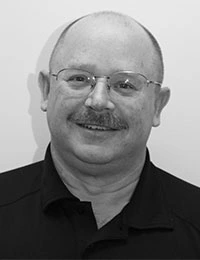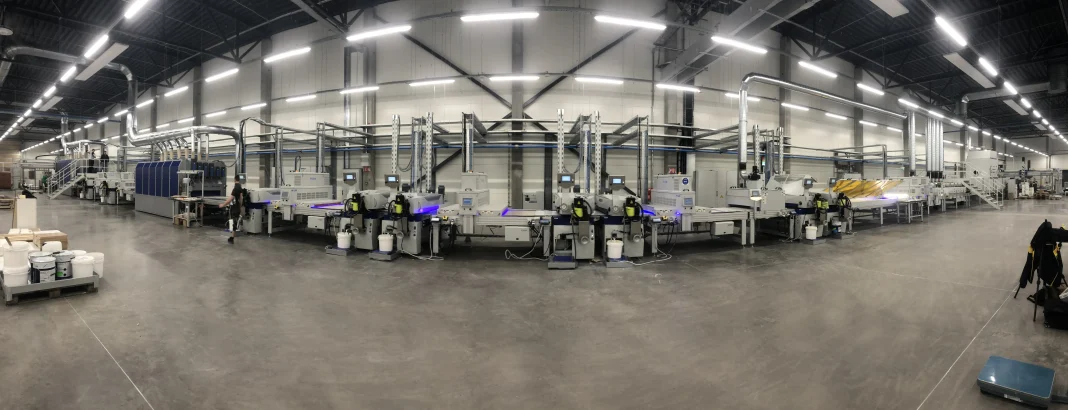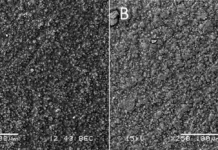As I enter the third year of writing this column, my plans are two-fold: 1) Tie the topic of this column to the issue focus and 2) Ask others in the industry for their input and thoughts.
In this issue, the focus is on UV cured wood products, including flooring, cabinets, furniture, molding and even guitars. Considerations for process control in wood applications are discussed in Part 1, and Thomas Efsen, managing director, and David Ivarsson, application and process engineer, both of EFSEN UV & EB Technology of Denmark, share their industry perspectives in Part 2.
Part 1: Process control on wood lines – What should you consider?
Product shapes: Wood lines often run a variety of different sized/shaped products and need to be configured to support the products, including UV cured edges.
Multiple lamp types: Different combinations of lamps are used for different parts of the process. Broadband mercury sources have shortwave UVC to help with surface cure, while mercury-gallium sources have longer wavelengths that can penetrate opaque coatings. LED-based wood lines use a combination of 365, 385, 395 and/or 405 nm LEDs. Some LED lines add a mercury source at the end to help surface cure.
Multiple lamps: Wood lines normally have multiple lamps (1 to 20), and each individual source needs to be optimized and maintained to deliver the expected:
- Irradiance value (W/cm2)
- Energy density value (J/cm2)
- Lamp type (i.e. mercury-gallium, 395 LED)
- Lamp focus (can impact gloss)
Multiband profiling radiometers allow the user to analyze each lamp with one pass through the UV production line. This is easier than measuring each lamp individually and guessing which individual lamp needs maintenance from a single irradiance and energy density value for all lamps. Maintenance can be targeted, and users can avoid running extra lamps just to “be sure.”
Process window: Work with the coatings supplier to develop a meaningful process window that includes both energy density (J/cm2) and irradiance (W/cm2) values. Infrared heat generated by UV lamp heads can have an effect on outgassing of components in a UV wood coating that affects lamp and reflector lifespan.
Environment: Maintenance is required more frequently in a wood facility than in a medical cleanroom. Dust settling on a UV system (reflectors, quartz plates, LED quartz windows) will reduce the UV reaching the cure surface. A drop in UVC relative to UVA usually indicates dirty reflectors. Follow the cleaning guidelines from the lamp supplier.
Line width: Uniformity across the width (4 feet/1.2 meters or more) of the line is important. The UV source, especially an arc lamp, should be wider than the widest product. Measure in multiple places across the width to assess the uniformity of the UV source or individual LED arrays. Watch for changes due to the reflectors, quartz plates or LED quartz windows getting dirty. Watch for arc lamp sagging or bowing, which change the position of the lamp relative to the reflector. This impacts both the amount and focus of UV reaching the cure surface and can indicate cooling issues.
Data collection: Use common sense. Place the instrument in the same location(s) each time and, as mentioned previously, record the energy density (J/cm2) and irradiance (W/cm2) values. Consider a fixture to prevent the instrument from “surfing” up and down across rollers. Understand the instrument limitations, including the sample rate, and avoid thermal ovens.
Equipment uniformity/maintenance: In an ideal world, production lines across all facilities would be the same. In the real world, this rarely happens. Develop a preventive maintenance schedule for each line and include time for measurements and maintenance in the production plan.
Coating properties: What properties listed below are important to the product? Understand which are formulation-driven and which are process-driven. For example, gloss levels can change based on the focus of the lamps. Consider resistance (abrasion, chemical, scratch, water), hardness (pencil, taber), weatherability, non-yellowing (clarity), tensile strength, gloss, color, coating viscosity, film thickness, ability to overcoat, sandability, adhesion and flexibility (cold cracking).
Part 2: Collaborative industry perspectives from Thomas Efsen and David Ivarsson of EFSEN UV & EB Technology
What words of wisdom can you share from your years of maintaining mercury-based UV lines?
There are many variables that impact radiometer performance. For our mercury-based radiometers, we state +/- 10% with +/- 5% typical. We normally see better performance (+/- 2%) on our LED radiometers based on the optics and narrow band nature of the LED source. Monitoring the output of a UV lamp over time and along the width of the lamp is crucial to meet curing requirements. Replace the reflector on a regular basis. Today’s UV measurement instruments are user friendly and should be used to learn, document and monitor the output of your UV systems. When there is an issue, the instruments can be used for problem solving to get your production back on track.
EFSEN began work on an LED (W-LED) system, initially designed for wood applications, over five years ago. Why?
We believe that LED technology has many benefits, including sustainability and process control, and it is the future of the UV industry. While the LED technology is modern and provides several advantages, it is not a magical, direct replacement for the conventional mercury technology. Formulation understanding, as well as process control technology, are keys for successful LED applications. Our system has integrated controls as well as filters to keep dust and other contaminants away from the LED array, key factors in a wood production environment.
From a process control point of view, how is LED different from broadband UV?
No UV source provides perfect uniformity. The output from a conventional source is lower toward the edges, and peaks in the middle, with some variations due to bulb or reflector deformation. A new LED source is more uniform and degrades slower, but the changes are more unpredictable than for conventional UV. An LED array consists of thousands of light sources that age independently, which can create a significant deviation.
Any thoughts about claims that UV LEDs are maintenance-free and do not need to be measured?
That shows a lack of understanding of the technology. Provided the quartz window stays clean, LEDs change slower than arc lamps. Maintenance does not have to be as frequent, but yearly maintenance does help ensure good performance, especially as the LED ages. A mercury bulb is replaced every few thousand hours, but an LED is expected to last tens of thousands of hours, so the variable effect of the aging along the array should not be disregarded.
What combination LED wavelengths (nm) are used? Do your lines utilize any mercury sources for surface cure?
The 395 nm LED is the most common choice in the market, as it was the first wavelength to reach a good price/performance. There now are several wavelengths available with a good price/performance ratio. Many processes can benefit from a 405 nm LED (for enhanced depth penetration, especially for pigmented systems and putties) or from the improved surface curing potential of a 365 nm LED. Some of our lines incorporate a mercury lamp at the end.
What are the measurement challenges with UV LEDs?
Performing accurate measurements of LED sources was extremely challenging using instruments designed for broadband mercury sources. The introduction of instruments with an optical response designed for the narrow band output and dynamic range of the LED solved this challenge. On systems with multiple types of LEDs, we easily can identify different LED types with a multiband LED instrument and confirm the performance of each.
What advice would you offer someone in the wood industry considering migration from broadband to LED sources?
Seek advice from an expert who knows both the LED equipment and the formulation/application implications of the technology. Knowledge of both is required for a realistic evaluation and to identify where LEDs make sense and what is required from a formulation point of view.
Read the full interview at www.uvebtech.com/articles/2021/perspectives-on-measuring-wood-lines/.
 Jim Raymont
Jim Raymont
Director of Sales
EIT LLC
jraymont@eit.com






